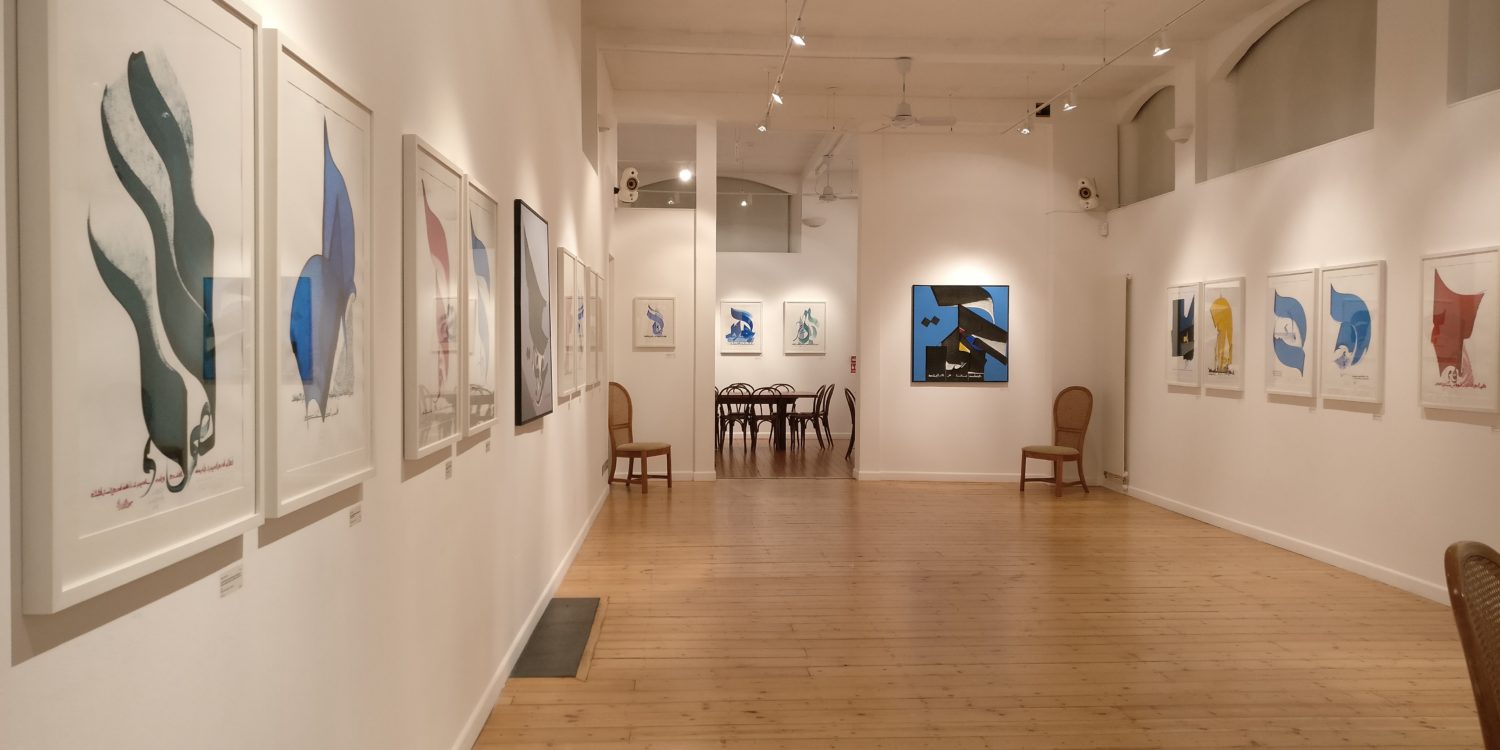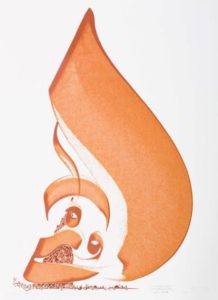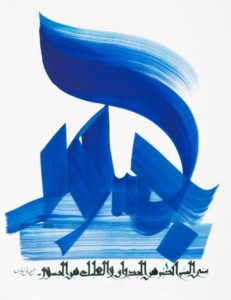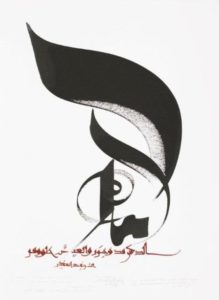Interview with calligraphy artist Hassan Massoudy on his exhibition ‘Hassan Massoudy: Breath, Gesture and Light’ at October Gallery, London
By Rosa Perez
“Through my art and my choice of humanist texts in my work I hope to bring a bit of hope, peace and tolerance to our society.” Hassan Massoudy
On Wednesday 24 January 2018, I managed to visit Hassan Massoudy: Breath, Gesture and Light exhibition at the October Gallery before it closed on 26 January.
Hassan Massoudy is an artist for whom the word itself remains the most sublime creative force. His work features the texts of a diverse range of writers, from poet, Charles Baudelaire and philosopher, Jean-Jacques Rousseau to Virgil and Ibn ‘Arabi. Born in 1944 in Najef, southern Iraq in a traditional Iraqi society, he moved to Baghdad in 1961, where he learnt the various classical styles of calligraphy, and studied graphic design and fine arts. His desire to study art, coinciding with the political events in Iraq at the time, saw him depart for Paris in 1969, where he enrolled at the École Nationale Supérieure des Beaux-Arts.
Massoudy’s work was exhibited and used as the primary promotional image for the British Museum’s 2006 exhibition, Word Into Art: Artists of the Modern Middle East. In 2007, October Gallery London, presented a solo exhibition of his work, Modern Arabic Calligraphy. In 2012, Gestures of Light – The Art of Hassan Massoudy, was exhibited at the Ghaf Art Gallery for ADMAF, Abu Dhabi. This Abu Dhabi Festival commission presented the Arab world premiere solo exhibition by one of the most celebrated artist-calligraphers of our time.
I found Massoudy’s calligraphy sublime and imbued with inspiring messages of positivity and hope. I was lucky enough to be able to share my observations with Massoudy himself, who very nicely agreed to answer my questions. For those who made it to the exhibition, and for those who missed it, I hope you enjoy this interview with Hassan Massoudy about his creative process as a calligraphy master and the meaning of his work.
When I saw your exhibition, I had an instant feeling of warmth and peacefulness. I had the impression that your works and the extracts of the texts that you chose are very positive, inspiring and uplifting.
All I aim for in my work is that the person who looks at it feels serenity, because art is a necessity for the human soul, as it is poetry and music. The excerpts of the texts that I turn into calligraphy are poetic and humanist.
I wonder whether the meaning of the words inspires your works, or it is the shape of the Arabic letters…or is it both of them?
There are times when I find sentences that are very beautiful and they allude to visions that I want to translate on paper, like the poetry of Ibn Munqidh from 12th century that says: “See the beautiful patience of the candle, which offers itself as light even as fire consumes it.” He talks about all the men and women that put their energy into illuminating others. There are other times, like with this proverb: “Don’t use two words where one will do” that the Arabic letters have inspired me. I have made the word ‘Kilma’ bigger. The letter ‘Kaf’ [ك] is like a zigzag, and the letter ‘lam’ [ل] is a right line and the rest are loops.
I wondered also if you use quotes and texts of authors from different times and places to make your Arabic calligraphy more familiar or approachable to the audience so they relate to it. Do you aim to build bridges between cultures through your art?
I use sentences that come from different cultures, by authors from the East and the West, and I also use texts from the old times. Eventually, there are human beings all around the world that experience humanist ideas and everyone can understand them.
I would like to know more about your work, your beginnings, your creative process and how you created your own style?
I choose a word from the sentence that I am working on, the main word, and I recreate it in much bigger dimensions, with its straight lines and its curves and a new geometrical structure. Then, I write the whole sentence underneath or on the side.
When I was observing your artworks, I was asking myself: ‘How many times must he have repeated and repainted this piece to make it so perfect?’
I repeat each calligraphy piece plenty of times with the aim of reaching the wanted strength and elegance. Sometimes these two don’t arrive so I have to wait for a few days and then, restart all over again. It takes a lot of patience.
If I think about your calligraphy, the colours that come to my mind are: blue, yellow and red. Would you say that these are the most representative colours within your work?
I prepare my own colours, like when we cook. I use pigments that are mixed in water with a binder. If I want to feel warm because the sky is grey and it is cold, I would mainly use warm colours like yellow and ochre. In fact, that will depend on my mood, my state of mind, the place where I am and on the message of the sentence too. It is difficult to explain the selection of colours because that depends on the sensations that are immersed in us since our childhood.
I have noted two types of illustrations at your exhibition; some works are on a white background, and others, in bigger dimensions, more vibrant, and with a richer combination of colours. Is there a reason for this? Could you comment a bit on this?
When I studied in Paris, 47 years ago, I used to do figurative oil painting on canvas. In 1975, I abandoned oil painting to go back to calligraphy on paper because it is the traditional support for calligraphy. But after some years working on paper, I wanted to explore another space and another type of support for my work and I rediscovered the canvas. On canvas I try to take over the space by colour covering the full background. Now I work with both: paper and canvas.
Could I say say after having seen your exhibition and your book ‘Calligraphies of Love’ published by Saqi Books in 2017, that the forces that move your inspiration are hope, peace and tolerance?
The artist has to be a committed person in society and has to be part of the elevation of culture. Through my art and my choice of humanist texts in my work I hope to bring a bit of hope, peace and tolerance to our society.




